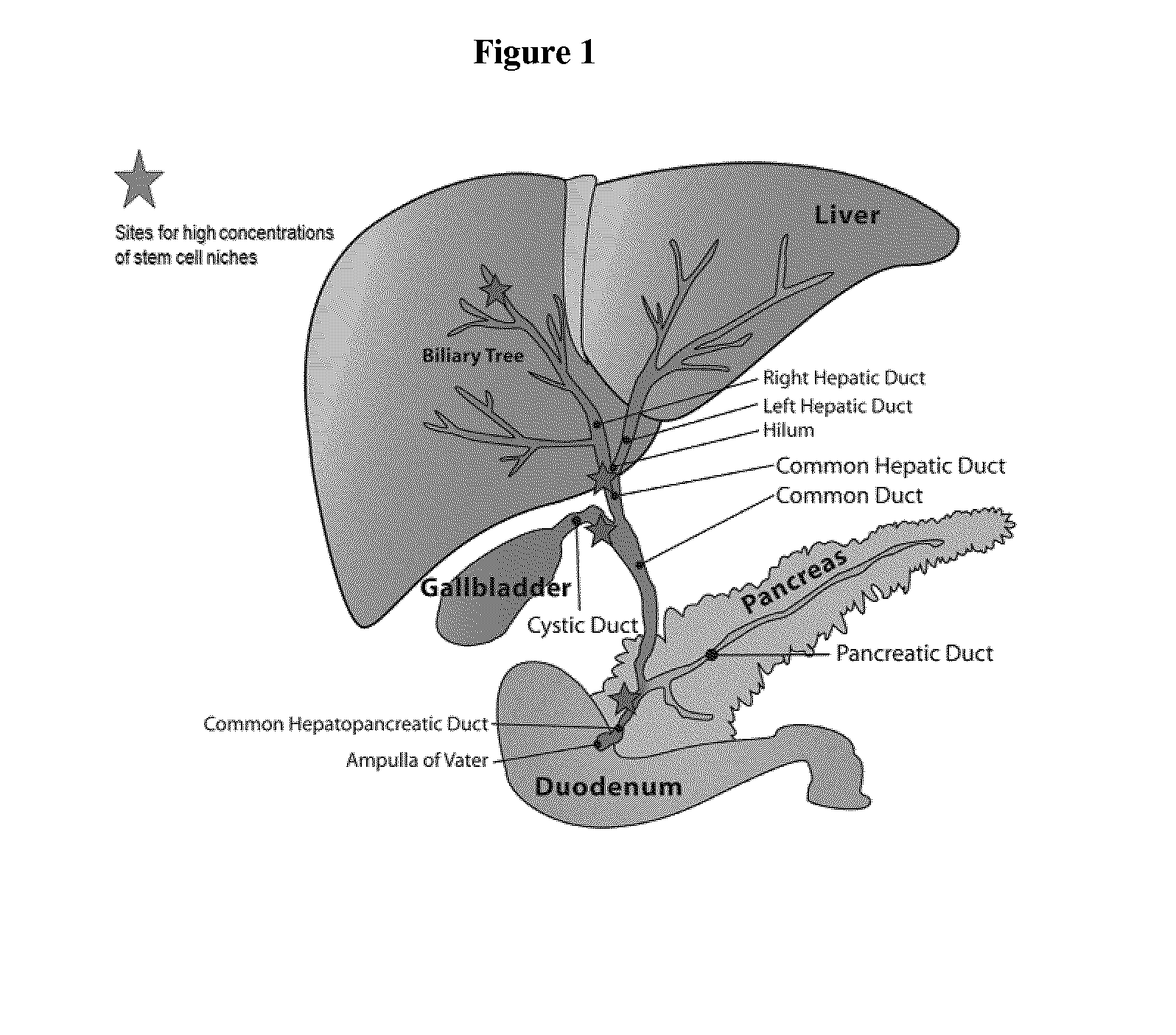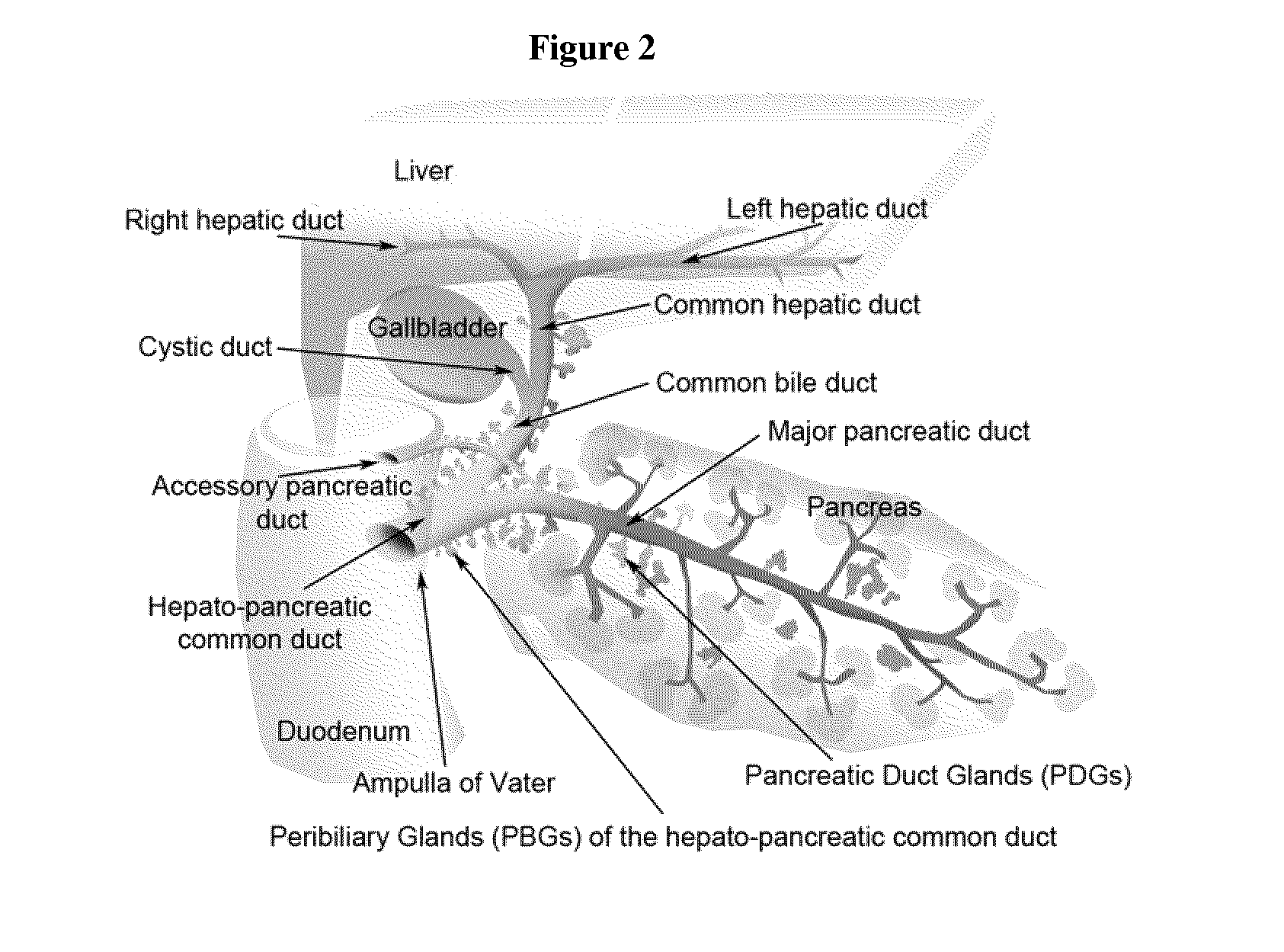Method of treating pancreatic and liver conditions by endoscopic-mediated (or laparoscopic-mediated) transplantation of stem cells into/onto bile duct walls of particular regions of the biliary tree
a stem cell and pancreatic cancer technology, applied in the field of cell-based therapies, can solve the problems of organ failure, major medical burden, health problems and deaths, and achieve the effects of avoiding immunosuppressive drugs for patients, avoiding ectopic cell distribution, and facilitating engrafting into the target organ
- Summary
- Abstract
- Description
- Claims
- Application Information
AI Technical Summary
Benefits of technology
Problems solved by technology
Method used
Image
Examples
example 1
Example of Efficacy of Grafting Strategy using Hyaluronan Grafts
[0104]Mouse hepatic progenitor cells were isolated from a host C57 / BL6 mouse (4-5 weeks) according to reported protocols. For the “grafting” studies, a GFP reporter was introduced into the hepatic progenitor cells. The cells were then mixed with hyaluronan (HA) hydrogels and the HA crosslinked prior to introduction into a subject mouse. For introduction / transplantation, mice were anesthetized with ketamine (90-120 mg / kg) and xylazine (10 mg / kg), and their abdomens were opened. The cells, with or without HA, were then slowly injected into the liver. The incision site was closed and animals were given 0.1.mg / kg buprenorphine every 12 hrs for 48 hrs. After 48 hrs, animals were euthanized, and tissue was removed, fixed, and sectioned for histology.
[0105]To determine cell localization within the murine models, “control” hepatic progenitor cells were infected for 4 hrs at 37° C. with a luciferase-expressing adenoviral vector ...
example 2
Pancreatic Stem Cells
[0107]Wang, et al., Stem Cells. 2013; 31(9):1966-1979, incorporated herein it its entirety by reference. Proximal (PBGs)-to-distal (PDGs) maturational lineages start near the duodenum with cells expressing markers of pluripotency (NANOG, OCT4, SOX2), proliferation (Ki67), self-replication (SALL4), and early hepato-pancreatic commitment (SOX9, SOX17, PDX1, LGR5), transitioning to PDG cells with no expression of pluripotency or self-replication markers, maintenance of pancreatic genes (PDX1), and expression of markers of pancreatic endocrine maturation (NGN3, MUC6, insulin). Radial-axis lineages start in PBGs near the ducts' fibromuscular layers with stem cells and end at the ducts' lumens with cells devoid of stem cell traits and positive for pancreatic endocrine genes.
[0108]Biliary tree-derived cells behave as stem cells in culture under expansion conditions, culture plastic and serum-free Kubota's Medium, proliferating for months as undifferentiated cells, wher...
example 3
Stem Cells in the Gallbladder
[0109]Gallbladders were obtained from organ donors and laparoscopic surgery for symptomatic cholelithiasias. Tissues or isolated cells were characterized by immunohistochemistry and flow cytometry. EpCAM+(Epithelial Cell Adhesion Molecule) cells were immunoselected by magnetic microbeads and plated onto plastic in self-replication conditions and subsequently transferred to distinct serum-free, hormonally defined media tailored for differentiation to specific adult fates. In vivo studies were conducted in an experimental model of liver cirrhosis.
[0110]Results: the gallbladder does not have peribiliary glands, but it has stem / progenitors organized instead in mucosal crypts. These can be isolated by immune-selection for EpCAM. Approximately 10% of EpCAM+cells in situ and of immunoselected EpCAM+cells co-expressed multiple pluripotency genes and various stem cell markers; other EpCAM+cells qualified as progenitors. Single EpCAM+cells demonstrated clonogenic ...
PUM
| Property | Measurement | Unit |
|---|---|---|
| Biodegradability | aaaaa | aaaaa |
Abstract
Description
Claims
Application Information
 Login to View More
Login to View More - R&D
- Intellectual Property
- Life Sciences
- Materials
- Tech Scout
- Unparalleled Data Quality
- Higher Quality Content
- 60% Fewer Hallucinations
Browse by: Latest US Patents, China's latest patents, Technical Efficacy Thesaurus, Application Domain, Technology Topic, Popular Technical Reports.
© 2025 PatSnap. All rights reserved.Legal|Privacy policy|Modern Slavery Act Transparency Statement|Sitemap|About US| Contact US: help@patsnap.com



